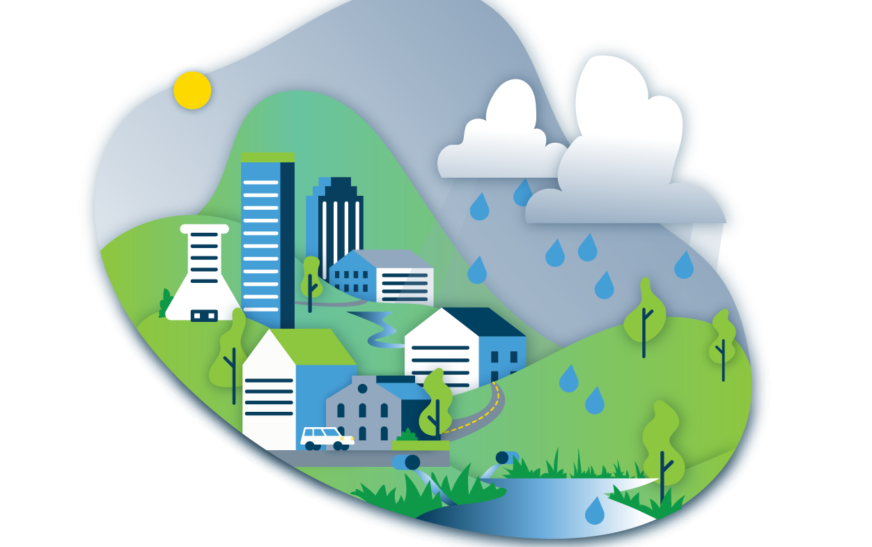Stormwater, the runoff from rainfall and snowmelt, is a natural part of the water cycle. However, in both urban and rural areas, unmanaged stormwater presents significant risks. When rainwater flows over impermeable surfaces like roads, parking lots, and rooftops, it can cause flooding, erosion, and pollution. Understanding these risks and implementing effective management strategies is crucial for protecting the environment and infrastructure.
The Risks Posed by Stormwater
Environmental Challenges
- Water Pollution: As stormwater flows over surfaces, it picks up pollutants such as oils, heavy metals, pesticides, and sediments. When this contaminated water enters rivers, lakes, and oceans, it can degrade water quality, harm aquatic life, and pose health risks to humans.
- Erosion and Habitat Destruction: Uncontrolled stormwater can lead to soil erosion, stripping away the earth and depositing sediments in waterways. This process can destroy habitats for fish and other wildlife, reducing biodiversity and altering ecosystems.
Infrastructural Challenges
- Flooding: In urban areas with extensive impermeable surfaces, stormwater runoff can overwhelm drainage systems, leading to localized flooding. This can cause property damage, disrupt transportation, and pose safety risks to residents.
- Strain on Public Utilities: Excess stormwater can overload sewage and drainage systems, resulting in overflows and increased maintenance costs. This strain on infrastructure can divert resources from other essential services.
The Importance of Effective Stormwater Management
Effective stormwater management is essential for mitigating these risks and protecting both natural and built environments. By implementing strategies, such as SWPPP like those in Idaho, that manage, treat, and reduce stormwater runoff, communities can enhance resilience, improve water quality, and safeguard ecosystems.
Management Strategies for Stormwater
Green Infrastructure
Green infrastructure uses natural processes to manage stormwater. Unlike traditional grey infrastructure, which relies on pipes and sewers, green infrastructure captures, filters, and absorbs runoff.
- Permeable Pavements: These specially designed pavements allow water to infiltrate the ground, reducing runoff and promoting groundwater recharge. Ideal for parking lots, sidewalks, and low-traffic roads, permeable pavements help to mitigate flooding and pollution.
- Rain Gardens: Rain gardens are shallow, planted depressions that capture and treat stormwater. They slow down runoff, allowing it to infiltrate the soil and be absorbed by plant roots. Rain gardens also enhance urban aesthetics and provide habitat for pollinators.
Retention Basins
Retention basins, or ponds, are designed to hold stormwater temporarily and release it slowly, reducing peak runoff rates. These basins improve water quality by allowing sediments and pollutants to settle before the water is discharged. They are effective in managing large volumes of stormwater and preventing downstream flooding.
Improved Drainage Systems
Modernizing and improving drainage systems is critical for effective stormwater management. This includes:
- Upgrading Infrastructure: Replacing outdated pipes and culverts with larger, more efficient systems can better handle increased runoff and reduce the risk of flooding.
- Implementing Smart Technologies: Using sensors and real-time monitoring systems can help manage stormwater more efficiently. These technologies provide data on water levels and flow rates, allowing for proactive management and maintenance.
Benefits of Effective Stormwater Management
Reducing Flooding
By implementing green infrastructure, retention basins, and improved drainage systems, communities can manage runoff more effectively. These strategies reduce the risk of flooding by slowing down and capturing stormwater, preventing drainage systems from becoming overwhelmed.
Preventing Pollution
Green infrastructure practices like rain gardens and permeable pavements filter pollutants from stormwater, improving water quality. This helps protect aquatic ecosystems and ensures safer water for recreational activities and human consumption.
Protecting Ecosystems
Effective stormwater management reduces erosion and sedimentation, preserving habitats for fish and wildlife. Retention basins and green spaces also provide natural areas for wildlife, supporting biodiversity and enhancing ecosystem resilience.
Conclusion
Effective stormwater management is vital for safeguarding the environment and infrastructure. By utilizing green infrastructure, retention basins, and better drainage systems, communities can reduce flooding, prevent pollution, and protect ecosystems. Collaboration among policymakers, urban planners, and residents is essential to create resilient and sustainable communities for a healthier future.













